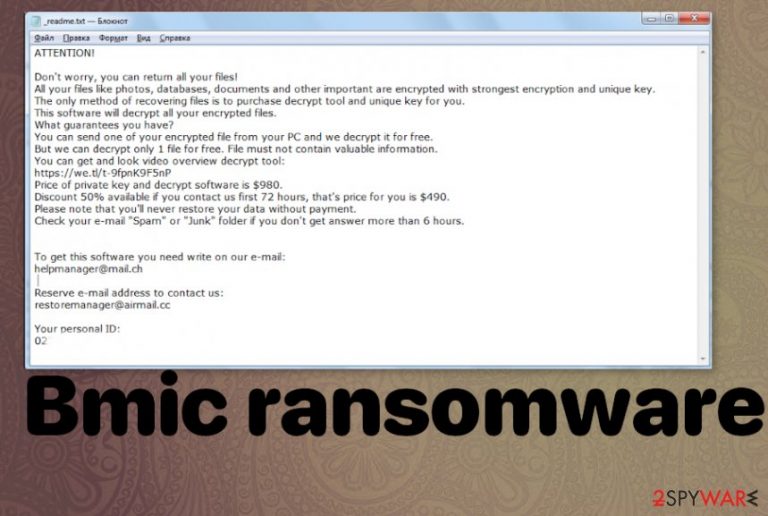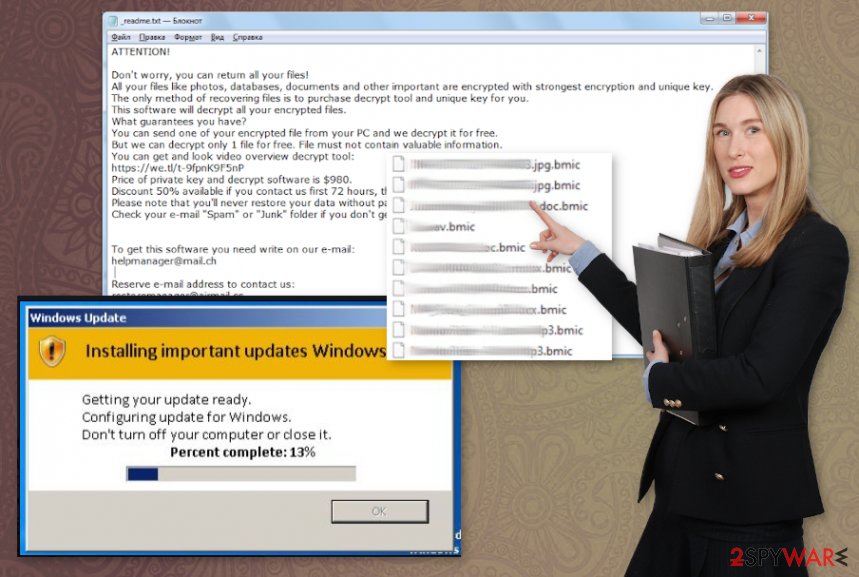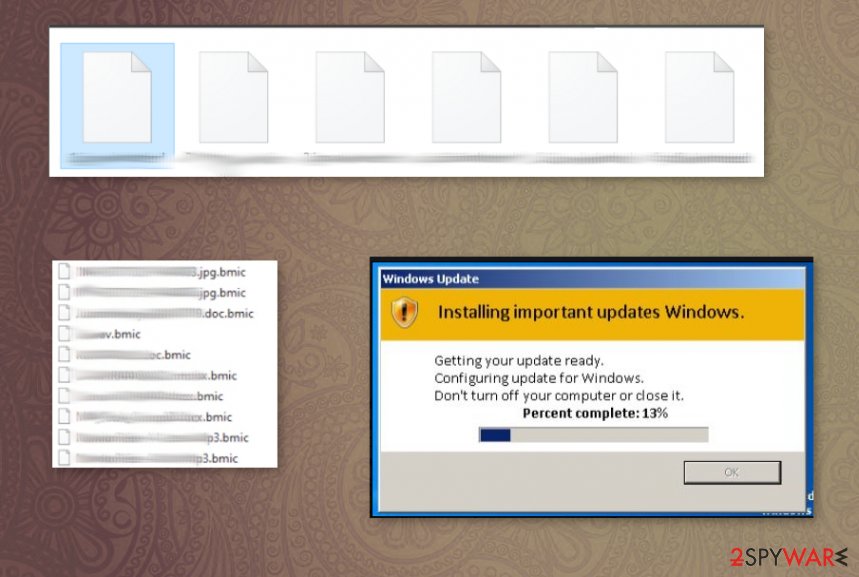Bmic ransomware (Virus Removal Guide) - Decryption Methods Included
Bmic virus Removal Guide
What is Bmic ransomware?
Bmic ransomware is the cryptovirus that demands money for alleged decryption that is, in most cases, not possible

Bmic ransomware virus is the file-encryption based threat that relies on army-grade algorithms and file encoding. When the original code of the particular file gets changed, and it receives the .bmci extensions after the original name and filetype extension, you also notice the ransom note file added on the desktop. _readme.txt is the message from criminals, ransomware creators, so you get informed about the Djvu ransomware family activities. This particular group of crypto-malware creators is known for delivering version after version, so neither the message nor the contact emails listed in the text file are changed for a while.
| Name | Bmic ransomware |
|---|---|
| Family | Djvu ransomware/STOP virus |
| File marker | .bmic – the appendix that gets added on files affected during the encryption process |
| Distribution | Fake updates, installers, pirated files, software, licensed programs, or video games. All these pieces of files can include malicious payload and trigger the infection on the machine |
| Ransom note | _readme.txt – file with the message from criminals behind this virus. This text file contains ransom amount specification, email addresses, Bitcoin wallet address |
| Issues | The virus developers claim to have decryption options, so people believe those lies and pay the ransom. These ransomware attacks can easily lead to money or data loss, permanent damage to your computer. Any threats that involve money are more dangerous than any other cyber infection |
| Elimination | Bmic ransomware removal process should include the usage of anti-malware tools because all the traces need to get deleted to terminate the virus fully |
| Repair | Try to recover after the attack by running the proper PC repair tool and fix the damage caused by ransomware. Try FortectIntego for the indication |
Bmic ransomware is the threat that focuses on encryption and money demands, so the first step when dealing with the infection like this would be ignoring any messages from criminals. There are no reasons to contact them, especially when you think about paying the demanded amount of $980/$490 in Bitcoin cryptocurrency.
Creators of this virus demand the payment in a text file _readme.txt that gets placed on the desktop once the Bmic ransomware attack starts and files get encrypted. The message is not changed for a while because the malware group focuses on releasing new variants all the time.
ATTENTION!
Don’t worry, you can return all your files!
All your files like photos, databases, documents and other important are encrypted with strongest encryption and unique key.
The only method of recovering files is to purchase decrypt tool and unique key for you.
This software will decrypt all your encrypted files.
What guarantees you have?
You can send one of your encrypted file from your PC and we decrypt it for free.
But we can decrypt only 1 file for free. File must not contain valuable information.
You can get and look video overview decrypt tool:
https://we.tl/t-gSEEREZ5tS
Price of private key and decrypt software is $980.
Discount 50% available if you contact us first 72 hours, that’s price for you is $490.
Please note that you’ll never restore your data without payment.
Check your e-mail “Spam” or “Junk” folder if you don’t get answer more than 6 hours.To get this software you need write on our e-mail:
helpmanager@mail.chReserve e-mail address to contact us:
restoremanager@firemail.ccYour personal ID:
When you receive the message from Bmic file virus creators try to ignore these claims and focus on cleaning the machine fully. You can achieve that by running an anti-malware tool that finds and removes traces of the infection. Unfortunately, that is not the process that could recover your encrypted data.
The success of Bmic ransomware removal process depends on the time that ransomware has already spent on the machine. The more affected your system gets the more difficult it is to delete the cryptovirus. You may experience issues with the machine when the particular functions get disabled, so you need additional help.

Dealing with .bmic file virus
The first step before you try to remove Bmic ransomware is to determine what you would like to choose for the file recovery after that. If you think that you can delete the treat and repair files with one AV tool, you should think again. Djvu ransomware uses various methods to ensure persistence, so you cannot decrypt or repair files easily.
When you think that there is no way to decrypt files in the future, you can go straight to removal and clean the machine from any traces of the Bmic ransomware virus. When you run FortectIntego, you can find and repair affected system files, registry entries, so functions run smoothly again. However, this is still not recovering your encoded data.
For files encrypted by the threat, you need to get a third-party recovery tool or rely on your data backups.[2] You should note that Bmic ransomware uses online IDs while encrypting files, so each key formed for the particular victim is unique and cannot be obtained easily.

Encryption starts one the payload of the ransomware is launched on the machine
You cannot know when the ransomware managed to affect your device because cryptovirus as any other more severe piece of malware can stealthily infiltrate the machine and trigger changes, launch malicious processes. The infection gets triggered by the users themselves because macro viruses get added on files that only need to be opened on the computer.
The more common way to spread this version of the ransomware is focussing on torrent sites, pirating platforms, and files that can spread during the installation and downloads of licensed versions of software, game cheats. You need to stay away from anything suspicious and illegal, so you can avoid infections like these. Experts[3] always note that there are many issues with pirating services, so do not get involved.
Recover files affected by the Bmic encryption virus and clear the traces of the threat
Focus on the proper tools, processes that can help you to remove Bmic ransomware from the machine. There is no easy way because this threat is residing in the memory, affecting more system files and other parts of the machine. You cannot manually find these pieces related to the infection, so automatic tools are needed.
The best tool for Bmic ransomware removal is security or anti-malware program. SpyHunter 5Combo Cleaner or Malwarebytes can check the system and indicate malicious programs, files related to malware. Then you need to follow suggestions and clear the system properly.
Any legitimate tools that can find the Bmic ransomware virus on your device should be able to eliminate all the traces. Unfortunately, to repair the system functions, programs, and other crucial files needed for the machine to run smoothly, you need something like FortectIntego.
Getting rid of Bmic virus. Follow these steps
Manual removal using Safe Mode
The system can be cleaned when you properly remove Bmic ransomware. You can achieve that by rebooting the machine in Safe Mode with Networking
Important! →
Manual removal guide might be too complicated for regular computer users. It requires advanced IT knowledge to be performed correctly (if vital system files are removed or damaged, it might result in full Windows compromise), and it also might take hours to complete. Therefore, we highly advise using the automatic method provided above instead.
Step 1. Access Safe Mode with Networking
Manual malware removal should be best performed in the Safe Mode environment.
Windows 7 / Vista / XP
- Click Start > Shutdown > Restart > OK.
- When your computer becomes active, start pressing F8 button (if that does not work, try F2, F12, Del, etc. – it all depends on your motherboard model) multiple times until you see the Advanced Boot Options window.
- Select Safe Mode with Networking from the list.

Windows 10 / Windows 8
- Right-click on Start button and select Settings.

- Scroll down to pick Update & Security.

- On the left side of the window, pick Recovery.
- Now scroll down to find Advanced Startup section.
- Click Restart now.

- Select Troubleshoot.

- Go to Advanced options.

- Select Startup Settings.

- Press Restart.
- Now press 5 or click 5) Enable Safe Mode with Networking.

Step 2. Shut down suspicious processes
Windows Task Manager is a useful tool that shows all the processes running in the background. If malware is running a process, you need to shut it down:
- Press Ctrl + Shift + Esc on your keyboard to open Windows Task Manager.
- Click on More details.

- Scroll down to Background processes section, and look for anything suspicious.
- Right-click and select Open file location.

- Go back to the process, right-click and pick End Task.

- Delete the contents of the malicious folder.
Step 3. Check program Startup
- Press Ctrl + Shift + Esc on your keyboard to open Windows Task Manager.
- Go to Startup tab.
- Right-click on the suspicious program and pick Disable.

Step 4. Delete virus files
Malware-related files can be found in various places within your computer. Here are instructions that could help you find them:
- Type in Disk Cleanup in Windows search and press Enter.

- Select the drive you want to clean (C: is your main drive by default and is likely to be the one that has malicious files in).
- Scroll through the Files to delete list and select the following:
Temporary Internet Files
Downloads
Recycle Bin
Temporary files - Pick Clean up system files.

- You can also look for other malicious files hidden in the following folders (type these entries in Windows Search and press Enter):
%AppData%
%LocalAppData%
%ProgramData%
%WinDir%
After you are finished, reboot the PC in normal mode.
Remove Bmic using System Restore
System Restore feature can help with your files and clear the system from traces of malware
-
Step 1: Reboot your computer to Safe Mode with Command Prompt
Windows 7 / Vista / XP- Click Start → Shutdown → Restart → OK.
- When your computer becomes active, start pressing F8 multiple times until you see the Advanced Boot Options window.
-
Select Command Prompt from the list

Windows 10 / Windows 8- Press the Power button at the Windows login screen. Now press and hold Shift, which is on your keyboard, and click Restart..
- Now select Troubleshoot → Advanced options → Startup Settings and finally press Restart.
-
Once your computer becomes active, select Enable Safe Mode with Command Prompt in Startup Settings window.

-
Step 2: Restore your system files and settings
-
Once the Command Prompt window shows up, enter cd restore and click Enter.

-
Now type rstrui.exe and press Enter again..

-
When a new window shows up, click Next and select your restore point that is prior the infiltration of Bmic. After doing that, click Next.


-
Now click Yes to start system restore.

-
Once the Command Prompt window shows up, enter cd restore and click Enter.
Bonus: Recover your data
Guide which is presented above is supposed to help you remove Bmic from your computer. To recover your encrypted files, we recommend using a detailed guide prepared by 2-spyware.com security experts.If your files are encrypted by Bmic, you can use several methods to restore them:
Data Recovery Pro is the program that can restore your files after encryption
When your files get damaged due by Bmic ransomware or accidentally deleted, you can recover them using Data Recovery Pro
- Download Data Recovery Pro;
- Follow the steps of Data Recovery Setup and install the program on your computer;
- Launch it and scan your computer for files encrypted by Bmic ransomware;
- Restore them.
Try the Windows Previous Versions feature and make your files accessible
When you use System Restore feature, you can rely on Windows Previous Versions
- Find an encrypted file you need to restore and right-click on it;
- Select “Properties” and go to “Previous versions” tab;
- Here, check each of available copies of the file in “Folder versions”. You should select the version you want to recover and click “Restore”.
ShadowExplorer method for encrypted files
Try the ShadowExplorer when Bmic ransomware is not affecting Shadow Volume Copies
- Download Shadow Explorer (http://shadowexplorer.com/);
- Follow a Shadow Explorer Setup Wizard and install this application on your computer;
- Launch the program and go through the drop down menu on the top left corner to select the disk of your encrypted data. Check what folders are there;
- Right-click on the folder you want to restore and select “Export”. You can also select where you want it to be stored.
Decryption tools for Djvu virus can possibly form for some files
Decryption tool for Djvu can helo with .bmic ransomware
Finally, you should always think about the protection of crypto-ransomwares. In order to protect your computer from Bmic and other ransomwares, use a reputable anti-spyware, such as FortectIntego, SpyHunter 5Combo Cleaner or Malwarebytes
How to prevent from getting ransomware
Protect your privacy – employ a VPN
There are several ways how to make your online time more private – you can access an incognito tab. However, there is no secret that even in this mode, you are tracked for advertising purposes. There is a way to add an extra layer of protection and create a completely anonymous web browsing practice with the help of Private Internet Access VPN. This software reroutes traffic through different servers, thus leaving your IP address and geolocation in disguise. Besides, it is based on a strict no-log policy, meaning that no data will be recorded, leaked, and available for both first and third parties. The combination of a secure web browser and Private Internet Access VPN will let you browse the Internet without a feeling of being spied or targeted by criminals.
No backups? No problem. Use a data recovery tool
If you wonder how data loss can occur, you should not look any further for answers – human errors, malware attacks, hardware failures, power cuts, natural disasters, or even simple negligence. In some cases, lost files are extremely important, and many straight out panic when such an unfortunate course of events happen. Due to this, you should always ensure that you prepare proper data backups on a regular basis.
If you were caught by surprise and did not have any backups to restore your files from, not everything is lost. Data Recovery Pro is one of the leading file recovery solutions you can find on the market – it is likely to restore even lost emails or data located on an external device.
- ^ Lindsey O'Donnell. ‘Double Extortion’ Ransomware Attacks Spike. Threatpost. IT and security nwews.
- ^ Elizabeth Lam. 6 Reasons You Must Have Data Backup and Recovery For Your Company. Hubstor. Data backup service.
- ^ Bedynet. Bedynet. Spyware related news.







